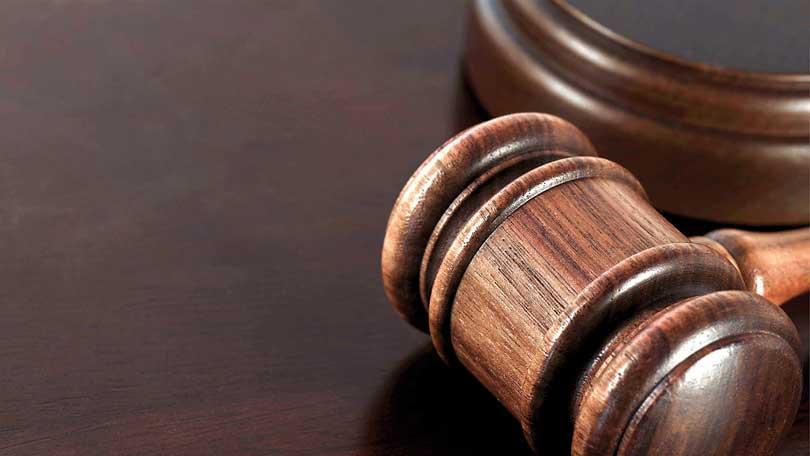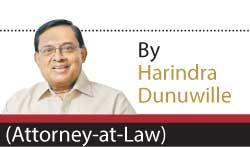Reply To:
Name - Reply Comment

 This is a reference to the matter of Ratnayake Mudiyanselagedara Abeyaratne Ratnayake of Kahalla in Katugastota under Section 51 of the Courts Ordinance 1889 in the Supreme Court (SC). The person charged was none other than the honourable (truly honourable) State Councillor A. Ratnayake, at the time an Advocate of the Supreme Court, later to be a member in the first Cabinet of independent Ceylon and last President of the Senate (President D.B. Wijetunga was his private secretary).
This is a reference to the matter of Ratnayake Mudiyanselagedara Abeyaratne Ratnayake of Kahalla in Katugastota under Section 51 of the Courts Ordinance 1889 in the Supreme Court (SC). The person charged was none other than the honourable (truly honourable) State Councillor A. Ratnayake, at the time an Advocate of the Supreme Court, later to be a member in the first Cabinet of independent Ceylon and last President of the Senate (President D.B. Wijetunga was his private secretary).
“The respondent, who is an Advocate and member of the State Council, was not counsel in the case. In answer to the following rule issued on him, he showed cause;
The court held that “the respondent’s letter amounts to an attempt to influence the judge upon a matter publicly before him and that the respondent’s conduct in writing the letter amounted to contempt of court”
The charge: Upon reading the letter of the Kandy District Judge dated March 15, 1938 and letters of March 12 and 24, 1938 written by Ratnayake Mudiyanselagedara Abeyaratne Ratnayake, addressed to the Kandy District Judge, it is ordered that the said Ratnayake Mudiyanselagedara Abeyaratne Ratnayake do appear in person and show cause before us on May 11, 1938 at 11:00a.m. in our court at Hulftsdorp, why he should not be punished for the offence of contempt committed against and in disrespect of the authority of the Kandy District Court, in that he, the said Ratnayake Mudiyanselagedara Abeyaratne Ratnayake, did by his letter dated March 12, 1938, addressed to the Kandy District Judge, attempt improperly to influence the said judge in the exercise of the functions of the said judge in the District Court Kandy Curatorship case No.2161.
In his judgment, Senior Puisne Judge Poyser states: “The following are facts: Proceedings were initiated in the Kandy District Court on October 25, 1937 by R. Somadu who moved that she be appointed curatrix of the property of her minor children. Her application was allowed on November 15, 1937 and various directions were given. On January 20, 1938, it appears that the stamps necessary for the certificate of curatorship had not been supplied and notice was served on the applicant, but she did not appear and consequently a warrant was issued for her appearance on March 31. On March 12, the respondent writes the following letter to the Kandy District Judge;
“Sir, I am given to understand that Rankotgedara Somadu is in delicate health, being pregnant, and is expecting a child at any moment. The Aratchi (reference is to the Headman – now Grama Niladhari), I understand, has sent a certificate to that effect. I would be grateful to you if you can grant a date to enable her to appear in court in response to the summons. I am, sir, your obedient servant, (Sgd.) A. Ratnayake.”
On January 20, 1938, it appears that the stamps necessary for the certificate of curatorship had not been supplied and notice was served on the applicant, but she did not appear and consequently a warrant was issued for her appearance on March 31
The district judge reports the receipt of the letter to the Supreme Court and calls upon the respondent for an explanation. He asks him whether such a letter was written in his capacity as an Advocate or State Councillor. In answer to that letter, the respondent states that he did not pen that letter in either of such capacities, but that he wrote it as he felt it his duty, as an ordinary citizen, to bring to the notice of the court that the person who had been summoned and against whom a warrant issued was in a delicate state of health and incapable, without danger to herself and to her unborn child, to attend the Kandy District Court.
I need only quote a passage in the judgment of Lord Chancellor Cottenham in the case of ‘In Re Dyce Sombre…’ (41 English Reports p. 1209).
“Every private communication to a judge, for the purpose of influencing his decision upon a matter publicly before him, always is and ought to be, reprobated; it is a course calculated, if tolerated, to divert the course of justice, and is considered and ought more frequently than it is, to be treated as, what it really is, a high contempt of court…”
As I said earlier, the contempt is not a serious one, but it amounts to an attempt to influence the judge upon a matter publicly before him, and it is very necessary, in my opinion, that such a course as the respondent has taken should be the subject of judicial action, and it is of great importance in this particular case where the respondent is not only an Advocate but a member of the State Council. Persons in the position of respondent must be made to realise that they cannot interfere with the course of justice and that if they do attempt to do so, they will be punished.
The respondent, who is an Advocate and member of the State Council, was not counsel in the case
The court held that “the respondent’s letter amounts to an attempt to influence the judge upon a matter publicly before him and that the respondent’s conduct in writing the letter amounted to contempt of court.”
However, R. L. Pereira, K. C., at the close of his argument, appreciated that the letter, written in the form it was, should not have been sent by his client and tendered an apology. In view of that fact, I think the rule may be discharged with a warning to the respondent.
KEUNEMAN, J.
I agree.
DE KRETSER, J.
I agree.
“Rule discharged with a warning.”
Such were the standards of the judiciary and of the judicial system themselves.